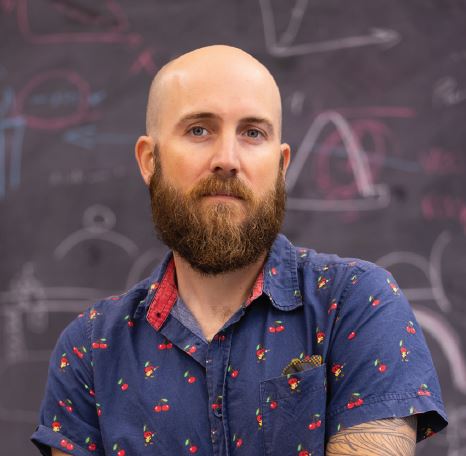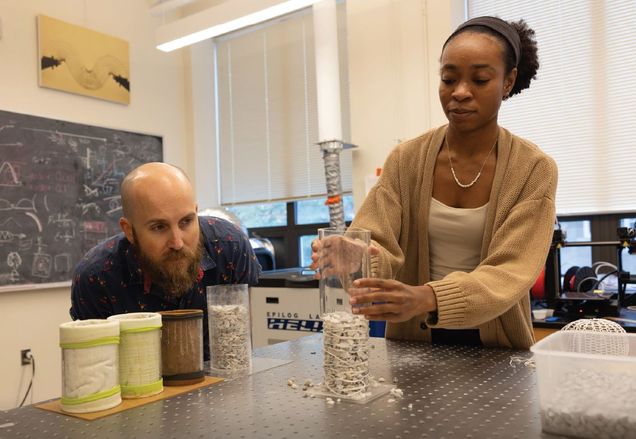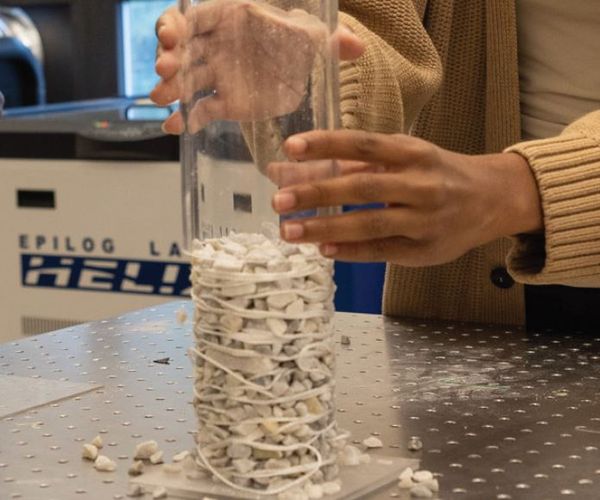Holmes lab pioneering a fast and lasting method of runway repair.
By Patrick L. Kennedy
Whether it’s materials with properties not found in nature or the most efficient energy-absorbing material ever, Boston University College of Engineering researchers are working across disciplines to pioneer materials solutions to a variety of pressing societal challenges. We call this convergent field Materials by Design. And in one case, the remarkable new material being developed starts with a pile of rubble.
With funding from a DARPA grant, Associate Professor Doug Holmes (ME, MSE) is working on efficient methods for quickly repairing a bomb-damaged airfield, then shoring up those repairs with biology. As with many defense projects, these methods might someday gain use in civilian life—emergency shelter construction following an earthquake, for example, or even non-emergency construction applications.
In the case of an airfield hit by a bomb, the immediate problem is a big crater in the runway. (Among Holmes’ collaborators is a munitions expert from Battelle Memorial Institute, who will use dynamite to create test craters.) When a base is attacked, Holmes says, “The goal at that point is to fly everybody out to safety as quickly as possible.”
The crater could be filled temporarily, but it’s not practical for an airbase to keep an entire cement-mixing apparatus and crew on hand just in case, nor is there time for the concrete to cure. Plus, the patch would have to be “rock-solid” and perfectly smooth to bear the load of an F-18 jet, Holmes says. “Otherwise, you’re at real risk of snapping that front axle on that plane.”

Elasto-granular jamming
The solution that Holmes is working on, along with colleagues from Batelle, MIT, and South Dakota School of Mines & Technology, is to take the rocky rubble from the blast and stick it back in the hole—in a smart way.
In previous work, Holmes and his then-student Arman Guerra (ENG’23) determined that it is possible to turn a loose pile of rocks into a sturdy column that can withstand an impressive amount of compressive force. The method for achieving this effect, which Holmes and current doctoral student Amani Campbell are now applying to the airfield project, is to loop elastic fibers (rope, for example) around the pile, in a mathematically intentional way, such that the fibers bind the rocks together. Campbell, who previously worked for a construction management firm, is even experimenting with pre-knitted “socks” for the rocks, to make it as easy as possible for emergency crews to reshape the rubble into upstanding columns.
“So you’re returning this collection of jumbled rocks into, essentially, one really stiff rock,” says Holmes. “And that stiffness is coming from the elastic material that’s preventing the rocks from moving.” The process is called “elasto-granular jamming,” in which the “elastic” material is the rope, and the “grains” are the rocks or other objects constrained by the elastic.
This MacGyver-like method might serve on its own as a quick fix. The elastically bound rock structures will hold for a while, and when a steel plate or other smooth covering is placed atop the refilled crater, evacuation flights can take off. However, a jammed structure is only “marginally stable,” says Holmes. Like in a Jenga tower, “Some of the grains are doing nothing, while others are bearing all the load.” Given that these structures are below the surface, eventually groundwater will seep in, likely shifting some rocks and compromising the system.

Making the fix last
Hence, a second step. “This is where the biology comes in,” says Holmes. “We seed the crater with enzymes that will grow into a network of really tiny fibers, acting almost like a glue.” As well, sand is added to the mix. So, just as the ropes jam the rocks (the big grains), the tiny fibers jam the small grains of sand. In this way, the system actually becomes more stable. “The biological component takes that temporary structure and adds the possibility for it to become more permanent.”
The airfield project will make a good case study, Holmes says. “We’ll test it under a variety of conditions and temperatures, and if we get this right, hopefully we can broaden its applicability.” In the future, Holmes would like to see such methods being used to build more natural sea walls and other grand structures that keep in harmony with their surroundings. “There’s something to be said for building structures that both integrate with the environment and get stronger over time.”
Campbell, whose home country of Jamaica was hit by Hurricane Beryl last summer, especially hopes her work can someday be useful in the aftermath of natural disasters. “I think my generation is a bit more conscious of the environment,” she says. “It would be nice to see some of these techniques being implemented.”
